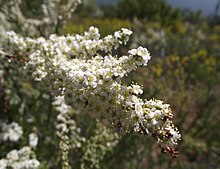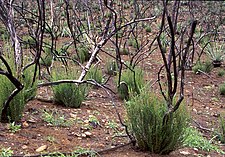Adenostoma
| Adenostoma | |
|---|---|

| |
| Adenostoma fasciculatum in flower | |
| Scientific classification | |
| Kingdom: | Plantae |
| Clade: | Tracheophytes |
| Clade: | Angiosperms |
| Clade: | Eudicots |
| Clade: | Rosids |
| Order: | Rosales |
| Family: | Rosaceae |
| Subfamily: | Amygdaloideae |
| Tribe: | Sorbarieae |
| Genus: | Adenostoma Arn.
|
Adenostoma is a genus of shrubs in the Rose family (Rosaceae) containing only two species, chamise (Adenostoma fasciculatum) and redshanks (Adenostoma sparsifolium). Both are native to the Californias.
Description
Characteristics
The plants grow in a habit of shrubs to small trees, and the stem is more or less resinous.[1] Both species in this genus feature stiff, linear leaves arranged alternately or in clusters along stems with shredding bark. Flowers form on a panicle, are cream to white and, as in all members of the rose family, have hypanthia.[2] The fruit is an achene. Chromosome number is 2n = 18.[1]
Distribution and habitat
Both species are native to coastal
Taxonomy
- Species of Adenostoma
-
Arn.- Chamise
-
Adenostoma sparsifolium Torr. - Redshanks
Phylogenetic analysis places Adenostoma closest to Chamaebatiaria and Sorbaria, and suggests tentative placement in the subfamily Spiraeoideae, tribe Sorbarieae.[3] The name Adenostoma comes from Greek, meaning "glandular mouth," referring to the hypanthium ring gland.[1]
References
- ^ a b c Jones, William (2012). "Adenostoma". Jepson eFlora. Jepson Flora Project (eds.). Archived from the original on 2015-12-18. Retrieved 18 December 2021.
- ^ a b Jepson Manual, University of California, 1993; Adenostoma
- ^ Montalvo, A.M.; Riordan, E.C.; Beyers, Jan (2017). "Plant profile for Adenostoma fasciculatum" (PDF). Treesearch. United States Department of Agriculture. Archived (PDF) from the original on 2020-03-19. Retrieved 15 October 2021.
External links


